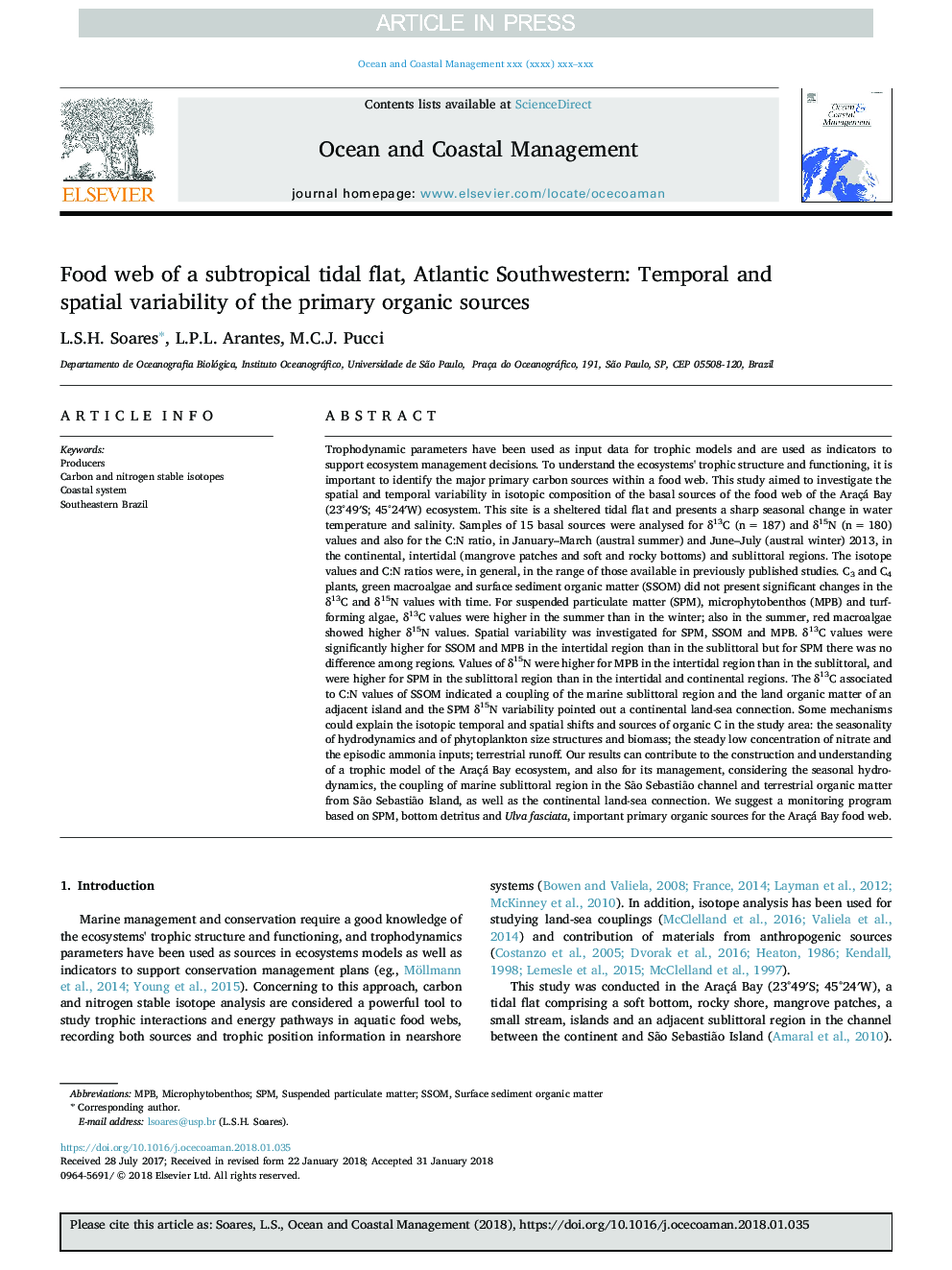| کد مقاله | کد نشریه | سال انتشار | مقاله انگلیسی | نسخه تمام متن |
|---|---|---|---|---|
| 11015662 | 1782045 | 2018 | 11 صفحه PDF | دانلود رایگان |
عنوان انگلیسی مقاله ISI
Food web of a subtropical tidal flat, Atlantic Southwestern: Temporal and spatial variability of the primary organic sources
دانلود مقاله + سفارش ترجمه
دانلود مقاله ISI انگلیسی
رایگان برای ایرانیان
کلمات کلیدی
موضوعات مرتبط
مهندسی و علوم پایه
علوم زمین و سیارات
اقیانوس شناسی
پیش نمایش صفحه اول مقاله

چکیده انگلیسی
Trophodynamic parameters have been used as input data for trophic models and are used as indicators to support ecosystem management decisions. To understand the ecosystems' trophic structure and functioning, it is important to identify the major primary carbon sources within a food web. This study aimed to investigate the spatial and temporal variability in isotopic composition of the basal sources of the food web of the Araçá Bay (23°49â²S; 45°24â²W) ecosystem. This site is a sheltered tidal flat and presents a sharp seasonal change in water temperature and salinity. Samples of 15 basal sources were analysed for δ13C (nâ¯=â¯187) and δ15N (nâ¯=â¯180) values and also for the C:N ratio, in January-March (austral summer) and June-July (austral winter) 2013, in the continental, intertidal (mangrove patches and soft and rocky bottoms) and sublittoral regions. The isotope values and C:N ratios were, in general, in the range of those available in previously published studies. C3 and C4 plants, green macroalgae and surface sediment organic matter (SSOM) did not present significant changes in the δ13C and δ15N values with time. For suspended particulate matter (SPM), microphytobenthos (MPB) and turf-forming algae, δ13C values were higher in the summer than in the winter; also in the summer, red macroalgae showed higher δ15N values. Spatial variability was investigated for SPM, SSOM and MPB. δ13C values were significantly higher for SSOM and MPB in the intertidal region than in the sublittoral but for SPM there was no difference among regions. Values of δ15N were higher for MPB in the intertidal region than in the sublittoral, and were higher for SPM in the sublittoral region than in the intertidal and continental regions. The δ13C associated to C:N values of SSOM indicated a coupling of the marine sublittoral region and the land organic matter of an adjacent island and the SPM δ15N variability pointed out a continental land-sea connection. Some mechanisms could explain the isotopic temporal and spatial shifts and sources of organic C in the study area: the seasonality of hydrodynamics and of phytoplankton size structures and biomass; the steady low concentration of nitrate and the episodic ammonia inputs; terrestrial runoff. Our results can contribute to the construction and understanding of a trophic model of the Araçá Bay ecosystem, and also for its management, considering the seasonal hydrodynamics, the coupling of marine sublittoral region in the São Sebastião channel and terrestrial organic matter from São Sebastião Island, as well as the continental land-sea connection. We suggest a monitoring program based on SPM, bottom detritus and Ulva fasciata, important primary organic sources for the Araçá Bay food web.
ناشر
Database: Elsevier - ScienceDirect (ساینس دایرکت)
Journal: Ocean & Coastal Management - Volume 164, 1 October 2018, Pages 104-114
Journal: Ocean & Coastal Management - Volume 164, 1 October 2018, Pages 104-114
نویسندگان
L.S.H. Soares, L.P.L. Arantes, M.C.J. Pucci,